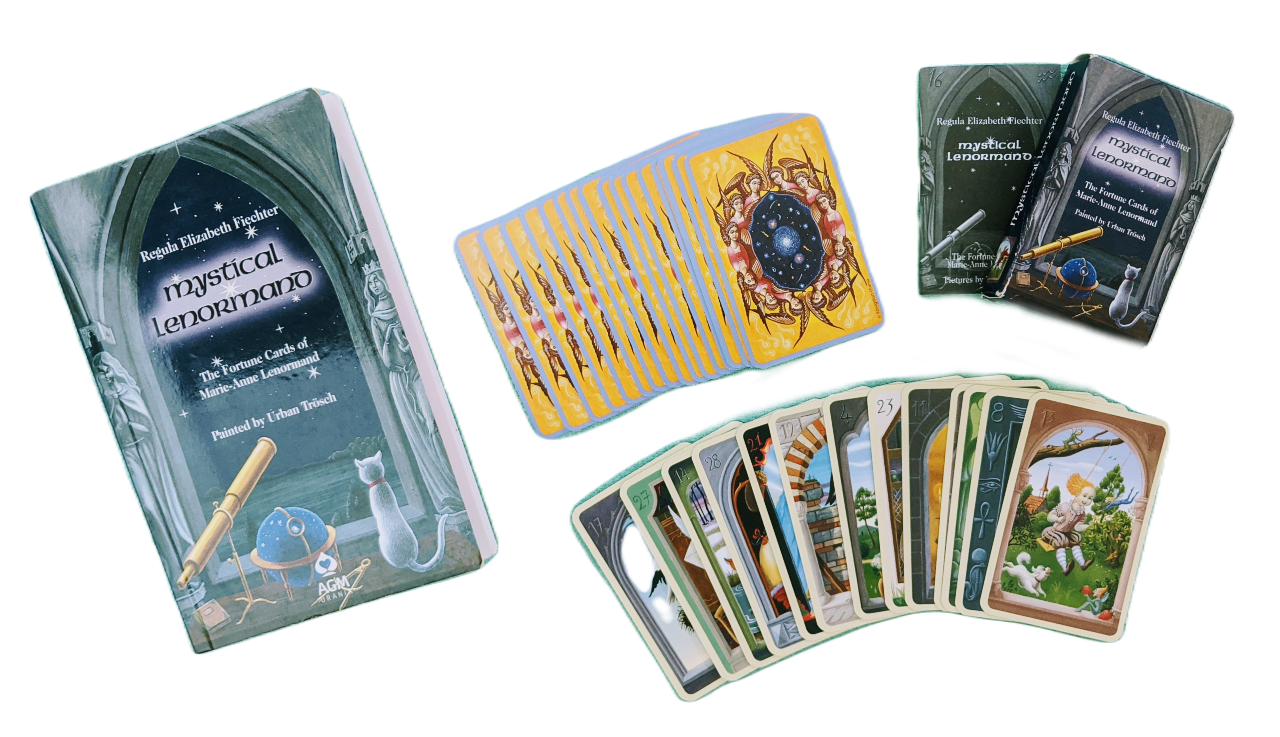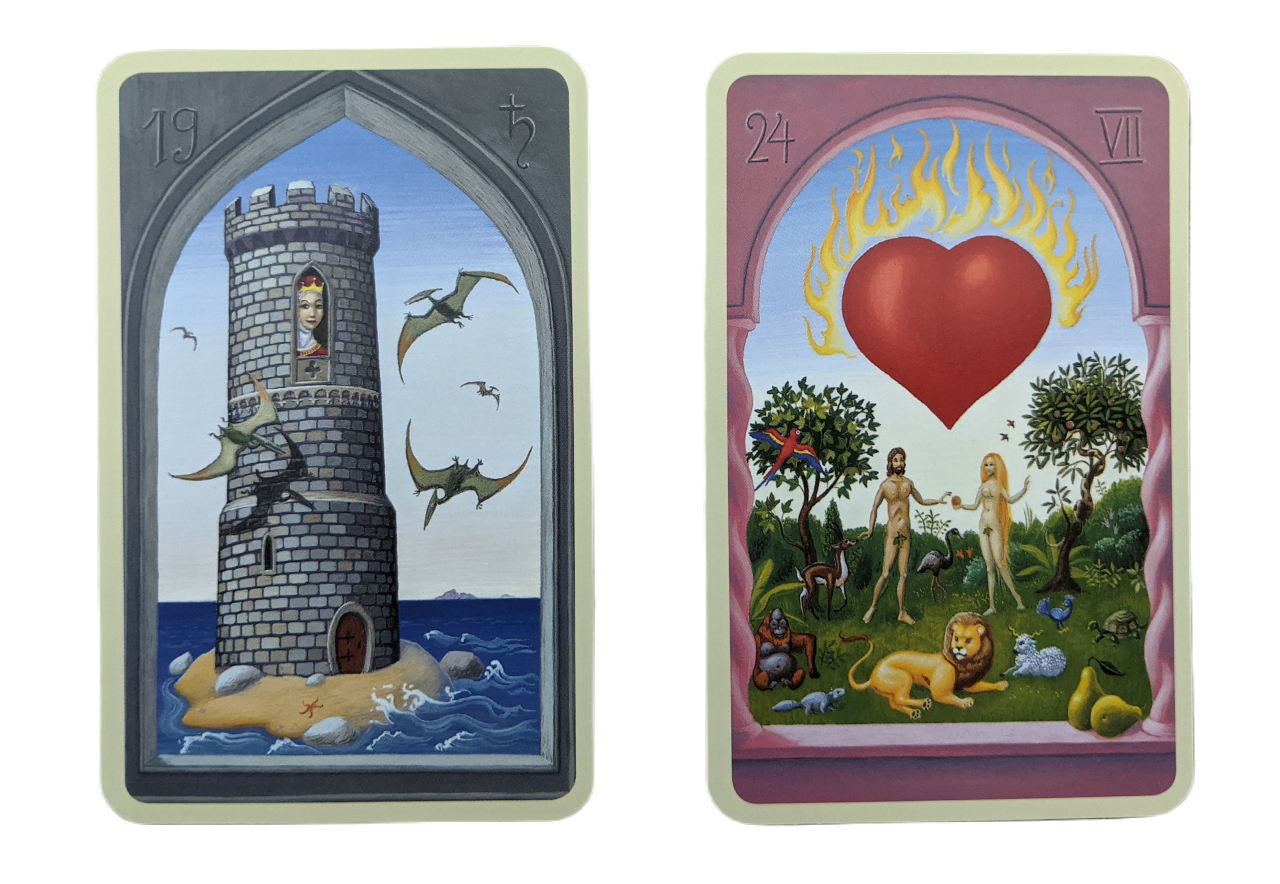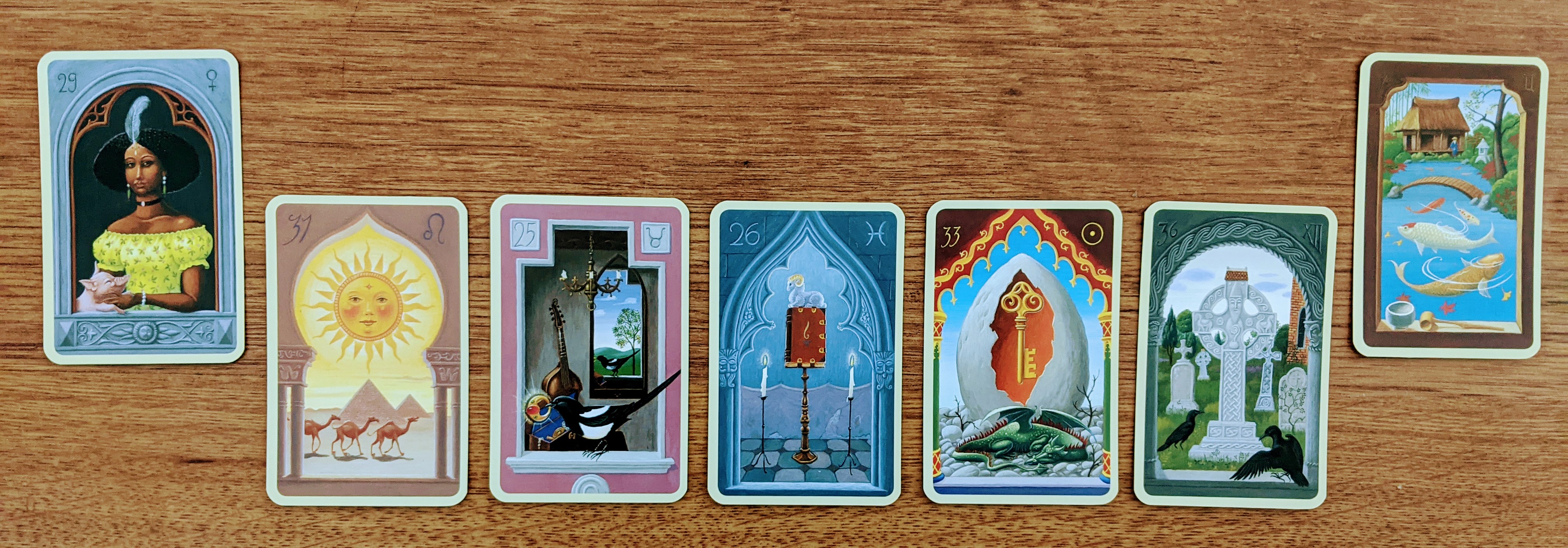
THE MYSTICAL LENORMAND BY REGULA ELIZABETH FICHTER
NOTE. In this post, “Guidebook” refers to the booklet accompanying the Mystical Lenormand deck, and “Book” refers to the Mystical Lenormand book by Fichter.
Regula Elizabeth Fichter’s Mystical Lenormand is a unique and meticulously crafted deck whose imagery and color are diverse, abundant, and detailed.
The deck illustrator, Urban Trosh, designed both of Fichter’s decks: The Mystical Lenormand and The Mystical Kipper.
In addition to her decks, Fichter wrote a complete two-card combinations dictionary, also called The Mystical Lenormand. Its cover design is exactly the same as on the card box: The Star card.
Let’s explore Fichter’s Mystical Lenormand deck, Guidebook, and Book.
DECK DESIGN & UNIQUE FEATURES
Fichter’s Mystical Lenormand and her book are both published by AGM Urania, which is a well-respected publisher of decks.
The Mystical Lenormand is a smallish deck whose cards are 8.9 x 5.6 cm (or 3.5 x 2.2 in). The back of each card is a beautiful illustration of angels surrounding the universe designed in a way that you can’t tell whether a card is upright or reversed.
I think this feature has aesthetic appeal, but it’s worth noting that, unlike with the Tarot, most Lenormand authors do not read cards in reverse. So my personal preference is that the back has a clear upright direction - it makes it easier to align the cards after shuffling them in a messy pile.
The deck comes with a small Guidebook that covers a few layouts, including the Grand Tableau, and a brief explanation of each card. The Book covers each card in more detail and more layouts.

The distinguishing feature of Fichter’s Book is that she offers an interpretation for every card pair. It is a complete two-card combination dictionary.
Her explanations for each combination are formatted in a handy bulleted list - unlike my dictionary, which is admittedly wordy!
Fichter’s deck is meticulously designed. The illustrator, Trosh, brings a wide range of colors with plenty of details. He used egg tempera to create the illustration. About this special technique, he writes:
“I favor this over all other techniques. I have a deep interest in traditional icons and medieval art, and therefore I was naturally led to this ancient painting method. The egg tempera does not contain poisonous solvents. All you need is diluted egg white and some vinegar for conservation, and, of course, color pigments. If you build a painting slowly, as I do, in small strokes of the brush, with very fine lines and smooth transitions, egg tempera is the way to do it!” (Book, p. 9)
Each card is a landscape of its own, with engrossing details that pull you into it. Some of the images are inspired by myth, others by Trosh’s imagination. The Heart, for example, represents Adam and Eve in the Garden of Eden.
A key and unique feature of the Mystical Lenormand is that every single card has an animal in it. This was Fichter’s request to Trosch.
He recalls:
“I was instructed to do anything I wished, with the exception of distorting a card interpretation and she offered me complete freedom with the designs (except that each card should illustrate at least one animal, a wish I happily complied with, as animals are one of my favorite subjects to paint).” (Book, p. 9)
I generally prefer designs that are less “busy” with detail, so I don’t have to “look” for the symbol in the card.
I would have liked for the Book, Clouds, Lily, Ring, Scythe, and Star, to stand out more against the rest of the card. The Ring in particular I feel is small in contrast with the rest of the card.

Still, their colors and designs are beautiful if not outright magical. And otherwise, all the other card symbols stand out saliently against their background. There is much to compliment about their colorful detail.
My favorite card is without question the Snake. Notice the Sun and Moon in the sky, the crown on the Snake’s head, and the egg it protects.
These alchemical symbols pay fair tribute to the archetypal power of the Snake as seen across a wide range of mythologies.

If I used this deck often, I feel I would interpret the Snake in a slightly different, deeper, and more positive way than the typically challenging associations we make with the Lenormand Snake, because Trosh’s design appeals to me with more grace and mysticism.
The card numbers are present on the cards but not the pip. Instead, Fichter has the astrological associations.
The number is on the top left and the astrological symbols on the top right. However, both insets are very discreetly illustrated, unlike most decks. They are drawn within the arch that surrounds the main card symbol.
The idea of an arch around the card emblem is pretty popular because it renders the card even more magical, drawing us into the emblem.
The Rana George Lenormand deck has them as well. In the Mystical Lenormand, each card has a uniquely designed arch.
CARD MEANINGS AND CARD COMBINATIONS
Fichter offers brief explanations for each card in the Guidebook that accompanies the deck.
In her Book, she offers plenty more detail for each card, and makes the significant contribution of explaining every single two-card combination.
Her easy-to-read, bullet list format makes her Book an accessible and handy tool for learning and working with combinations. I encourage you to have a look through as it will most likely inspire your own interpretation of two-card lines and beyond.
Despite some differences between my and Fichter’s interpretations, I feel hers are intuitive and easy to resonate with. Here are a couple of my favorite examples.
For the Ring, part of Fichter’s explanation for it is that “...it can refer to a prenuptial agreement or a contract of employment. It also implies a repetitive action, such as going round in circles.” (Book, p. 173)
She associates the Ring with a seven-year time period, repetitive or bonded action, a group or people, and with the sign of Taurus.
Personally, I think of the Ring as suggesting one relationship or closer connections, and I leave the idea of groups to the Dog or Garden.
I think Fichter might associate the Ring with seven years because it is card number 25, and reducing this number using numerology reduction technique produces 7 (2+5).
As for my astrological correspondence of the Ring, I associate it with Libra, the sign of balance in relationships.
Some of the combinations Fichter gives for the Ring include:
- With the Rider, “contract or bond, marriage proposal.”
- With the Tree, “relationship for life.”
- With the Snake, “relationship to a woman, contract for a woman, disagreements constantly repeating themselves.”
- With the Scythe, “sudden relationship, dangerous relationship.”
- With the Bear, “old married couple, connection to a man, bound by contract.”
- With the Fox, “betrayal in a relationship.” (Book, pp. 174-175)

To compare her interpretations with mine, I interpret the Ring and Scythe as indicating divorce, and the Ring and Snake as betrayal. I feel the Fox is softer than the Snake, though I still see the Fox and Ring as suggesting lack of trust and a non-committal attitude toward the relationship.
Notice Fichter’s interesting interpretation of the Ring and Bear. That’s because she associates the Bear with an attorney or an official (Book, p. 113).
Titania Hardie has a similar understanding of the Bear as seen through her interpretation of the Bear and Lily. She writes this pair “always” represents matters of the law (Titani'as Fortune Cards Guidebook, p. 52). To learn more about Titania’s take on Lenormand, read this post.
Another example is the Tower. Fichter interprets it as negative overall: “This is not a pleasant situation. You feel locked in and isolated. But it might also be the case that you have reached your limit and you are looking for strength in loneliness. This is when you withdraw to be alone. The card may also stand for a separation…” (Book, p. 137).
The characteristics she associates with the Tower are “alone, egoistic, introverted, reckless, withdrawn, lonely, separated, high.” As a person, it represents an official, a manager, or an egotistical male. And its astrological attribution is Saturn.
Some interesting combinations are:
- With the Rider, “thoughts of a separation, climbing the career ladder.”
- With the Clover, “temporary separation, separation brings luck.”
- With the Clouds, “trouble with authorities (dark side), trouble with authorities clears (bright side), complacency.”
- With the Scythe, “surgery forces withdrawal, aggressive boss.”
- With the Heart, “lonely heart, shows no feelings.”
- With the Fishes, “bank, powerful businessman.” (Book, pp. 140-141)

Because Fichter covers every single card pair, it can be really helpful to refer to her guide when you’re stuck at a combination.
You don’t have to adopt any one author’s suggestion. Instead, get inspired by several authors you resonate with, and get help with jogging your interpretive imagination, especially when you’re first getting started.
For each card, Fichter associates with it a time factor, characteristics, persons, and an astrological attribution. These associates are what I call correspondences.
Correspondences are what the cards mean for a specific context like work and career, health, money, relationships, etc.
Fichter uses the term “correspondences” as well but only for astrological associations apparently. (Book, p. 274)
I cover ten correspondences for each card in the Card Combinations Master: (1) As a person’s character, (2) for health, (3) as a profession, (4) for money and finances, (5) in relationships, (6) for time and timing, (7) as a place, (8) as an object, (9) spiritually, and (10) its astrological attribution.
Although Fichter mentions some of them under each card, she lists her complete people / animal (personality) and astrological correspondences in the Appendix back of her Book (pp. 270-276).
LAYOUTS AND INTERPRETATION TECHNIQUES
In the Guidebook that comes with the deck, Fichter covers three layouts: Past-present-future, the Grand Tableau (which she calls the All Cards spread), and the Runway layout, which she created herself. In her Book, she covers the same ones but adds several others.
One curiosity is that the Runway layout in the Guidebook is called the Landing Strip in her Book. The purpose of this layout is to determine how to reach a goal.
As this is her own creation, let’s explore it a little.
She writes:
“Do you have a particular aim but no inkling on how to achieve it? Draw your Personal Card (29 Lady or 28 Gentleman) and draw a card from the deck which represents your desires. If, for instance, you are seeking a new job, choose card 36 Anchor. Now put the Personal Card to the left and the card for your objective some distance to the right… Three to seven cards at most show you the way to reach your objective comfortably and without danger.” (Book, p. 261)
I’m not sure what she means by “without danger” but I like her approach to this layout. I like the idea that you can choose anywhere from three to seven cards, and I also appreciate that although “it is ideally suited for casual questions” (Book, p. 261),” it is focused on how to achieve a specific goal.
There aren’t many layouts I’ve come across in Lenormand that maintain the flexibility of reading sentences without becoming too specific like Tarot readings.
To take an example, let’s draw a line of five between myself, the Woman, and my goal, increasing my income which I represent with the Fish. And I get these cards.

Though the Book is associated with secrets, it’s also about knowledge, research, writing, and more broadly, creativity. Seeing it in the middle of the line focuses the reading and answer.
It appears that I need to share my knowledge or perhaps create more books and resources - as I do write and share my knowledge using literature and written resources.
The Sun and Ring clearly tells me that I can increase my income by making more connections such as increasing my subscribers, and nurturing existing relationships.
The Key and Cross are spiritual cards, and although the Key is focused on solutions, the Cross is a little heavier and could be guiding me toward doing the things that are more deeply associated with my life purpose.
How about using Fichter’s combinations! Let’s string them forward, from left to right.
Sun and Ring suggest “happy relationships, a good contract.” (Book, p. 212) The first part is similar to my interpretation, but I didn’t think of a contract. The Ring and Book are the pair I normally interpret as a contract or a proposal.
Ring and Book represent a “marriage contract, hidden relationships.” (Book, p. 176) Hidden relationships don’t really apply but perhaps I could stretch this to mean tapping into existing relationships. Perhaps, unbeknownst to me, someone in my contacts can give me good ideas or help me land an opportunity.
Book and Key suggest, “secret will be deciphered (open side), secret will not be deciphered (closed side), success with exams.” (Book, p.182) Exams don’t really apply unless getting certified in something helps. It makes sense for some people but not for myself as far as I can tell right now. And I would think that by open versus closed sides of the Book, Fichter means the side of the book that we open to read it as opposed to its spine.
Key and Cross mean “completion, certainty is predetermined.” (Book, p. 225) I’m not sure what Fichter means by the second suggestion, but the first can indicate success in the context of my question.
Note that I’ve looked up the combination meanings under the first card of each of these combinations. Reversing the order of each pair changes some meanings except in the case of the Ring and Sun.
For the Book and Ring, Fichter keeps the secret relationship aspect, but adds the idea of a “study association.” (Book, p. 182) The Key and Book is an “open secret.” (p. 224) And the Cross and Book suggest “karmic insight is prohibited, akashic records.” (p. 242)
If you come across authors that take into account the order of the cards and offer different meanings for different orders, I suggest that you look up both when interpreting your cards because it can help expand the possibilities.
QUOTABLE QUOTES
Fichter has some wonderful insights when it comes to the practice of Lenormand. I feel they also apply with other decks and with the practice of divination in general.
She suggests,
“Never predict a serious illness or death, no matter how much you are convinced that you can tell the future from the cards. Predictions of death are taboo on ethical grounds and be careful when you predict a divorce or a relationship separation too. Focus on the constructive and positive, because these are what will help someone through a crisis.” (Book, p. 19)
Though I agree that predicting things like death and divorce are tricky and can be ethically questionable, I care to note that it is not because of a limitation of the divinatory tool - in this case, the cards.
A divination tool is indifferent to the events of the world - it is just an object. It is our ethics and intentions that guide how we use this tool.
Personally, I avoid discussing someone’s death with clients, but it can appear in the cards, and I do deal with this topic in my personal readings.
Divorce and separation on the other hand are very common topics, and I deal with them often with clients as relationship questions are the most frequent ones I get for readings.
This said, it is important to understand the bigger context of a client’s question, and get clarity about whether they are looking to leave or stay in a relationship.
But I completely agree with Fichter that the goal is to “help someone through a crisis.” As you’ve heard me say often: If you can’t do anything about reading, then what is the point of doing it?
NOTE ABOUT THIS POST This blog post and/or video are produced in good faith to promote the author’s work and bring together the Lenormand community. If the author(s) or his/her representative(s) has any concern with the information presented, kindly write to Layla, the Lenormand Reader. Layla, the Lenormand Reader, reserves all rights.

Want To Become A Lenormand Reader?
Lenormand Reader’s Certification Program is the only one of its kind, in size and in depth, to help you master the amazing Lenormand deck. This Program is filled with knowledge and practice accumulated through 20+ years of study and practice. It is organized into a real body of knowledge and delivered with best in class, online, on-demand video. Join the waitlist so you secure your spot when registration opens.
Join Lenormand Reader’s Certification Program
